

Ancient lineage of algae found to include five 'cryptic' species. All land plants originated from a single evolutionary event when freshwater algae got a foothold on land, giving rise to an astonishing biodiversity of plants on earth.

However, the group of algae that would later give rise to land plants had already been living and evolving in both freshwater and terrestrial habitats for over one billion years. There is a tiny group of these algae still living that are most distantly related to land plants. A team from the University of Göttingen honed in on one species of these rare algae, Chlorokybus,that forms "cell packages" and lives in wet soil and rock cracks. The researchers discovered that Chlorokybus contains not one, as previously thought, but at least five different species. The results were published in the Proceedings of the Royal Society B. Symbiotic salamander/algae relationship may inspire new drugs. Spotted salamanders are unique among vertebrates, in that they're the only ones whose embryos have an algae living inside of them.
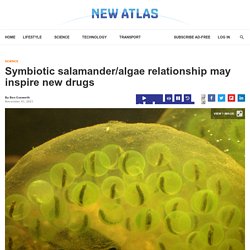
Scientists are now hoping that a better understanding of this symbiotic relationship could lead to new drugs for humans. For some time now, it has been known that when the spotted salamander (Amblystoma maculatum) lays its eggs in aquatic environments, those eggs are harmlessly infiltrated by a green algae known as Oophila amblystomatis. This can actually be seen in the green coloration of the egg clusters. It's a win/win scenario, as the algae feed upon nitrogen-rich waste produced by the embryos, while the embryos benefit from the waste removal and the oxygen produced by the algae. More recently, however, it was found that algal cells actually make their way into tissue cells throughout the embryos' bodies. Climate change may be driving Lake Superior algae blooms. Israeli vegan 'tech-style' startup making clothes using algae - CNN Style.
Written by Rebecca Cairns, CNN The global fashion industry employs millions of people and is worth trillions of dollars.
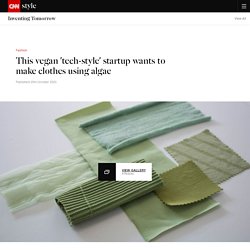
It also accounts for 10% of global carbon emissions and creates pollution and waste: in the US, just 15% of textiles are recycled, while the rest are incinerated or sent to landfill. That's why one Israeli startup is creating a biodegradable, non-toxic, and low-energy textile — using algae. Its algae formula can be used to create natural fibers and dyes using less water than conventional products, and producing zero waste and pollution, said Renana Krebs, CEO and co-founder of Algaeing. The company hopes to "harness the power of renewable algae to create a real, genuine impact against climate change," she said. A green solution. Evidence found of sea slugs stealing photosynthesizing machinery from algae, using it to boost reproduction.
A team of researchers affiliated with multiple institutions in Portugal and France has found evidence suggesting that sea slugs that steal photosynthesizing machinery from the algae they eat use it to boost their own reproduction efforts.
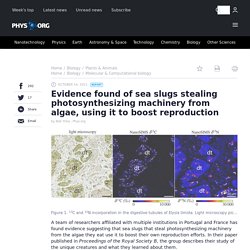
In their paper published in Proceedings of the Royal Society B, the group describes their study of the unique creatures and what they learned about them. Prior research has shown that some kinds of sea slugs retain photosynthesizing machinery (chloroplasts) from the algae they eat and then store it in their own bodies for long periods of time—sometimes for as long as a year. And remarkably, during the storage period, the chloroplasts remain functional. Scientists use drones to document the return of Californian kelp forests. Kelp forests are one of California’s most precious coastal habitats.
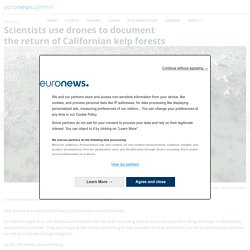
For the third year in a row, Vienna Saccomanno and her team are using drones to survey kelp sites along the coast of Mendocino and Sonoma counties. They are mapping the carbon-absorbing brown seaweed so that the habitat can be protected and continue its role as a climate change mitigator. So far, the results are promising. Seaweed to cow feed: Why is Sweden building the world’s largest algae factory? A Swedish start-up is building the world’s largest algae factory to create emission-reducing seaweed feed for cattle.
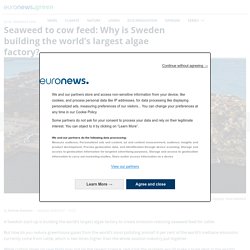
But how do you reduce greenhouse gases from the world’s most polluting animal? 4 per cent of the world’s methane emissions currently come from cattle, which is two times higher than the whole aviation industry put together. While cutting down on cow farts may not be the sexiest science, reducing the problem would make a huge dent in the world’s greenhouse gas emissions, and help dairy and beef farming become much more sustainable. “There are more than one billion cows on the planet, and the emissions from these continue to increase.
Despite that, there are no widespread solutions to decrease the emissions, and research in the field is progressing far too slow,” says Fredrik Åkerman, co-founder and CEO. Yahoo fait désormais partie de Verizon Media. Yahoo fait partie de Verizon Media.

En cliquant sur « Tout accepter », vous consentez à ce que Verizon Media et ses partenaires stockent et/ou accèdent à des informations sur votre appareil par l’intermédiaire de cookies et technologies similaires, et traitent vos données personnelles, afin d’afficher des publicités et contenus personnalisés, mesurer les performances des publicités et contenus, analyser les audiences et développer les services. Australian Wildfires Triggered Massive Algal Blooms in Southern Ocean – Raises New Questions About Oceanic Carbon Uptake. A satellite image shows smoke from the 2019-20 Australian wildfires covering parts of the Southern Ocean.
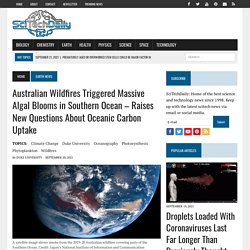
Credit: Japan’s National Institute of Information and Communication Technology. Credit: Japan’s National Institute of Information and Communication Technology. Diatoms, an Evolutionary Mystery, Come into Nano-Focus. The other day a friend introduced us to a novelty among household conveniences — kitchen and bath mats made from diatomaceous earth, rich in fossil diatoms.
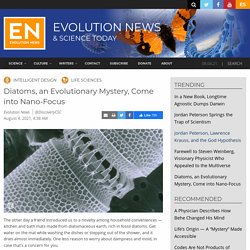
Get water on the mat while washing the dishes or stepping out of the shower, and it dries almost immediately. One less reason to worry about dampness and mold, in case that’s a concern for you. The world, indeed, should know more about the microbes called diatoms. When you hear the word “microbe,” what comes to mind? Using Sunlight to Acquire Energy: A Genome of Photosynthetic Animals Decoded. The photosynthetic sea slug, Plakobranchus ocellatus type black, (left) and an electron micrograph displaying sequestered algal chloroplasts within a sea slug cell (right).
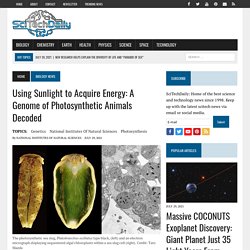
Credit: Taro Maeda. Ingenious Ocean Microbes Team Up Brilliantly To Gather Food When It’s Scarce. Coscinodiscus wailesii diatom with attached Pseudovorticella coscinodisci ciliate epibionts. Streak lines were derived from flows generated by the ciliate epibionts. The source video was captured at 500 frames per second and the image integrates particle paths over a 200 frame interval. Credit: Kanso et al, PNAS, 2021.
Littlest Shop of Horrors: Hungry Green Algae Prefer to Eat Bacteria Alive. A brightfield image of Pyramimonas parkeae (left) and a green fluorescence image of the same algae, revealing the ingested bacteria inside the cells (right). Credit: N. Bock & E. Yahoo fait désormais partie de Verizon Media. Yahoo fait partie de Verizon Media. En cliquant sur « Tout accepter », vous consentez à ce que Verizon Media et ses partenaires stockent et/ou accèdent à des informations sur votre appareil par l’intermédiaire de cookies et technologies similaires, et traitent vos données personnelles, afin d’afficher des publicités et contenus personnalisés, mesurer les performances des publicités et contenus, analyser les audiences et développer les services.
Données personnelles pouvant être utilisées Informations relatives à votre compte, à votre appareil et à votre connexion internet, y compris votre adresse IP Informations relatives à votre navigation et historique de recherche lors de l’utilisation des sites web et applications de Verizon Media Localisation précise Vous pouvez sélectionner l’option « Personnaliser mes choix » afin d’obtenir d’autres informations et de gérer vos préférences.
Vous pouvez modifier vos choix à tout moment en consultant Vos paramètres de vie privée. Could Algae Help Solve India’s Pollution Crisis? Why Some Scientists Aren’t Giving Up Mystery of photosynthetic algae evolution finally solved. Landsat Data Warns of Harmful Algal Blooms. Rare fossilized algae, discovered unexpectedly, fill in evolutionary gaps. When geobiology graduate student Katie Maloney trekked into the mountains of Canada's remote Yukon territory, she was hoping to find microscopic fossils of early life. Even with detailed field plans, the odds of finding just the right rocks were low. Genetic Scalpel Invented for Microalgae to Efficiently Turn CO2 Into Biofuel. Hundred-kilobase fragment deletions in microalgae by Cas9 cleavages.
This figure was made using BioRender. Credit: LIU Yang A single-celled alga undergoes genome surgery to remove non-essential parts. Algae extract may act to slow down COVID progression. Writing in the journal Marine Biotechnology, a team identifies a Spirulina extract as capable of decreasing the secretion levels of a protein that sets in motion the cytokine storms seen in patients with COVID-19. Although the researchers point out the work is at an early stage with results seen in in vitro test conditions, the team point to Spirulina’s European regulatory acceptance as a dietary supplement as reasons for optimism.
“When the algae extract was included in optimum quantities, there was a 70% reduction in the release of TNF-α proteins, which is very encouraging,” explains lead study author Dr Asaf Tzachor. “This indicates that the algae extract may be used to prevent cytokine storms if given to patients soon after diagnosis,” he adds. Scientists are making biodegradable flip-flops out of algae. Algae used to give bioprinted tissue an oxygenated boost. One of the challenges in 3D printing biological tissue lies in the fact that the cells may die before oxygen-delivering blood vessels grow into the material. Harvard scientists are addressing that issue, by adding algae to the mix.
Led by Asst. Prof. Photosynthetic printing material gets stronger with exposure to light. Recent advances in synthetic biology of cyanobacteria. Wound-healing patch of blue-green algae mends skin quickly. Dunaliella. Dunaliella is a single-celled, photosynthetic green alga, that is characteristic for its ability to outcompete other organisms and thrive in hypersaline environments.[1] It is mostly a marine organism, though there are a few freshwater species that tend to be more rare.[2] It is a genus where certain species can accumulate relatively large amounts of β-carotenoids and glycerol in very harsh growth conditions consisting of high light intensities, high salt concentrations, and limited oxygen and nitrogen levels, yet is still very abundant in lakes and lagoons all around the world .[3] It becomes very complicated to distinguish and interpret species of this genus on simply a morphological and physiological level due to the organism’s lack of cell wall that allows it to have malleability and change shape and its different pigments that allows it to change colours depending on the environmental conditions.
History of knowledge[edit] Sugar turns brown algae into good carbon stores. You may like them or not, but almost everyone knows them: brown algae such as Fucus vesiculosus, commonly known as bladderwrack, grow along the entire German coast. Giant kelp like Macrocystis or Sargassum grow closely together along the coasts but can also form floating aggregates that can cover the Atlantic from west to east. This Type of Algae Absorbs More Light for Photosynthesis Than Other Plants. About 2.5 billion years ago, a pigment called chlorophyll appeared in single-celled organisms, allowing them to capture energy in the form of light and convert it into sugars. Algae inside blood vessels could act as oxygen factories. Sargassum seaweed links Amazon rainforest fires and the Caribbean Islands. Cyanobacteria use micro-optics to sense light direction. Pacific Ocean Iron Level Mystery Solved.
Can Better Photosynthesis Help Feed the World? Diatom Microbubbler for Active Biofilm Removal in Confined Spaces - ACS Applied Materials & Interfaces. Diatom microbubble scrubber destroys dangerous biofilms (w/video) Robots Made from Algae, Powered by Magnets Can Kill Cancer, Swim Through Blood. This robot made of algae can swim through your body—thanks to magnets.